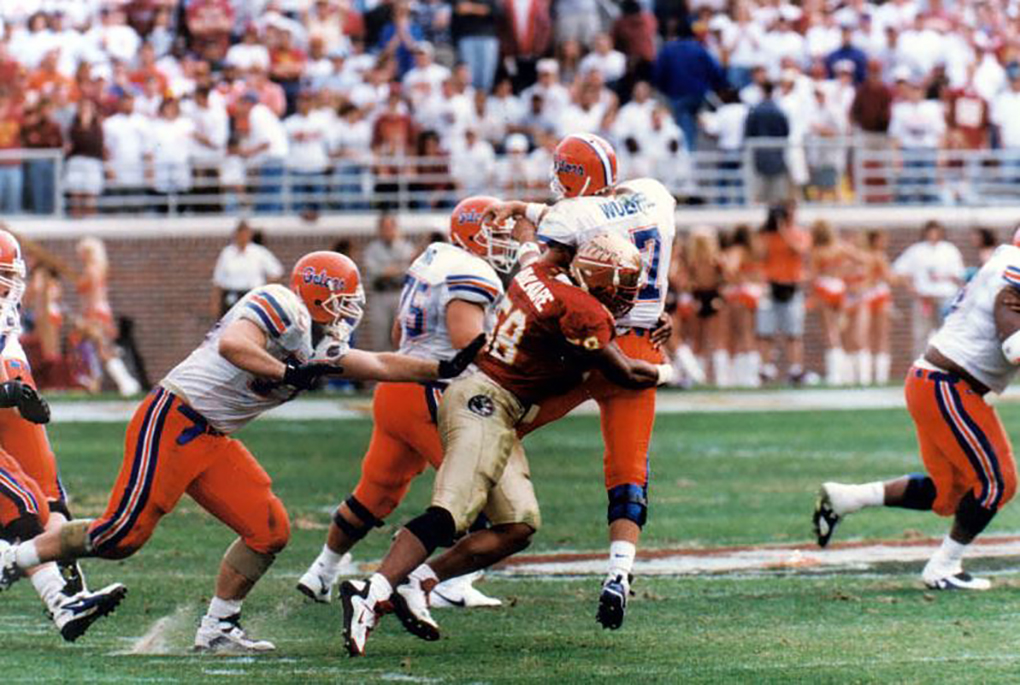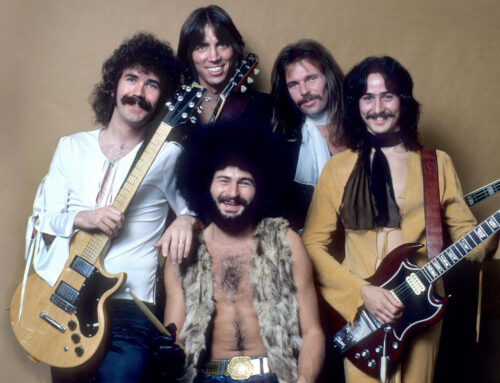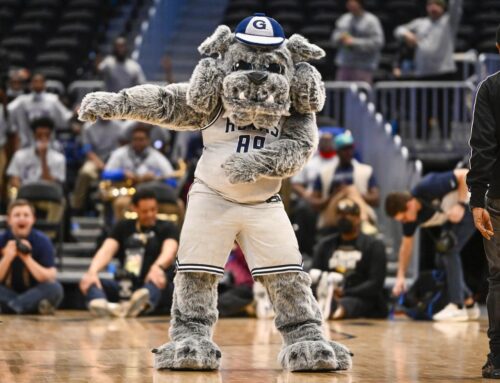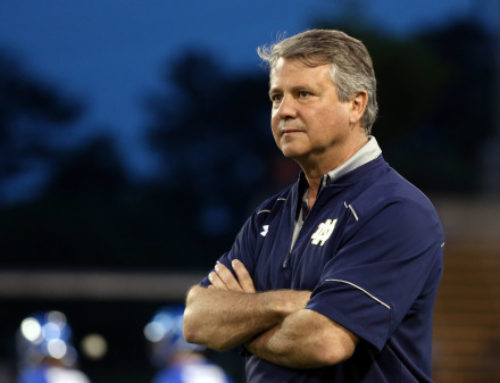Unless you have been in a bomb shelter the last couple of years, you are by now aware that 2023 will be the final season of the 4-team playoff era. College football will move to a new method for determining its champion beginning in the 2024 season with a 12-team playoff – the top 6 ranked conference champions and the 6 best at-large teams.
We’ve already gone over the pros and cons for Notre Dame itself in this system, but in this series we will examine some of the high-stakes regular season games of the past that were essentially undone by the postseason that came after it. Since we can get used to this occurring just about annually once the 12-team CFP arrives, it feels like a good time to consider how these results led to what we now have.
There are probably good examples of “Every Game Counts” proving to be untrue prior to this, but I feel like a key marker for the regular season not being treated as paramount came in 1996, with the Florida/Florida State rematch for the national title.
The Preamble
By 1996 a lot of college football fans were sick of not getting a true national championship game due to the Pac-10 and Big Ten’s relationship with the Rose Bowl (so quaint to think back on that now that the B1G decided to just kill the Pac-12 because they could), and ’96 was the first of two straight years of that issue flaring up again, leading to the advent of the BCS.
Led by standout quarterback Jake Plummer, who finished third that year in the Heisman voting, Arizona State vaulted onto the national scene in ’96. In week three, the Devils made their mark with a stunning 19-0 win over Nebraska, ending a 26-game winning streak by the two-time defending national champions. (I was 9 at the time and remember being absolutely flabbergasted when I heard that Nebraska lost a game.)
ASU benefited from a hilariously weak Pac-10 that had only one other team ranked in the final regular season AP poll – #13 Washington, whom the Sun Devils edged 45-42 two weeks before beating the Huskers. (Worth pointing out, since this is a ND site, that the Irish clubbed UW 56-20 that season.)
Still, the Nebraska win and the mostly dominant way ASU dispatched its opposition – they needed a 21-point comeback to beat UCLA and then escaped USC in double OT the next week, but they rolled in the other five league games – pushed them up to #3 in the polls heading into the final week of the regular season.
The two teams ahead of ASU were archrivals Florida and Florida State, in that order, and that set up what was at the time still a rare #1 versus #2 showdown at Doak Campbell Stadium. I have to believe the atmosphere for what felt, at the time, like a de facto semifinal was off the charts.
The Game
What a game it was. Florida State relentlessly pressured Gators QB Danny Wuerffel, who got his – 362 yards passing – but also threw three interceptions and spent a decent amount of time with his face in the turf as FSU sacked him six times. Spurred by a huge day from Warrick Dunn, who ran for 185 yards, the Noles led 17-0 before staving off a late Gators rally – with the help, of course, of a Gators field goal going wide right early in the fourth quarter.
Coach Bobby Bowden said after the game that if his team didn’t have the best defense in the country, it would have lost. At the time it seemed hard to argue.
What happened next
FSU’s win earned it a bid to the designated Bowl Alliance championship game, which that year was the Sugar Bowl. Their presumed opponent was Nebraska, which that same day beat Colorado in what at the time was considered a de facto playoff quarterfinal (the Huskers were #4 and CU was #5) to win the North division of the then brand-new Big 12.
All the Cornhuskers had to do to secure a shot at FSU was take care of unranked Texas in the Big 12 championship. Funnily enough, that would have created a scenario where the Alliance title game could actually result (provided they won the Rose Bowl) in the championship being awarded to Arizona State despite the Sun Devils not playing in it. Had ASU won and Nebraska won out, it seems hard to believe the unbeaten Devils would’ve been bumped behind a team it convincingly beat on the field.
Of course, college football happened.
UT’s win opened the back door for #4 Florida, and the Gators burst through it, defeating Alabama in the SEC championship later that day 45-30. Big Ten champ Ohio State was sitting at #5 but was locked in opposite the Sun Devils in the Rose Bowl.
The Sugar Bowl had no alternative unless it wanted to grant a shot at the Alliance title to BYU, the next-highest ranked team. The Cougars, who entered the weekend ranked #6, had gone 13-1, but their only ranked win was #22 Wyoming in the WAC championship game. BYU moved up only to #5, past Nebraska, giving the Gators the title-game rematch.
Oddly enough, it was the second time in three years FSU and Florida met in a Sugar Bowl rematch – the two teams had tangled in the 1994 Sugar Bowl, coming weeks after the infamous “Choke at Doak” game where FSU rallied from down 31-3 to tie the Gators and knock them out of that year’s Bowl Coalition national title game, the Orange Bowl. That rematch came about mostly because SWC champion and top-10 ranked Texas A&M was ineligible for postseason play, which created an absurd five-way tie for the league title at 4-3 that somehow resulted in 6-5 Texas Tech getting a Cotton Bowl bid. You might also remember that Notre Dame itself got a major bowl bid that year (the Fiesta against Colorado) that it wouldn’t have gotten in a normal year as a result of all this weirdness. (College football was better when it made absolutely no sense at all, in my opinion.)
The rematch
1996 Internet being what it is, I can’t find mention of whether any old-timey columnists decried the idea of a national championship rematch, something that Notre Dame fans know had been studiously avoided in 1988, 1989 and 1993, all years the Irish were prominently involved in the discussion, and all in which the idea had come up but ultimately not come to pass.
The rematch was Jan. 2, 1997, one day after the Rose Bowl. The Sun Devils had a chance to make their own case for the national title, but were unable to do it as Ohio State rallied in the final moments to win the game. Once again, the door was opened for Florida. Once again, Florida, which had been crushing all comers in ’96 until losing round 1 to FSU, broke it down with authority.
The final score was 52-20, with the Gators utterly dominating the second half. Ohio State could and did make a feeble argument to be ranked #1 – and did get a very small minority of first-place votes, including one half-and-half vote that I would love to see explained – but the polls were overwhelming. Florida was national champion. They remain to this day the most recent college football program to win its first national title, and I honestly don’t know if that will ever change.





Was the half vote for a split title (between two teams)?
I’m sure it was, but 1) I don’t know how that’s allowed, and 2) I would love to know who thought they could pull it off.
Have I spent the past half hour trying to Google information on this first place half-vote? Maybe
In the 1998 coaches poll, 8 coaches split their vote between Nebraska and Michigan, 28 picked Nebraska outright, and 26 picked Michigan outright. What an incredible sport.
I baaaaaaaaaaarely remember watching this game as a kid with my cousin, who was a huge Florida fan. Love posts like this.
Also, when I go back and watch old games that Keith Jackson called, I really wonder why he was ever considered a great announcer. He gets tons of stuff wrong and frequently sounds bored. I don’t get it.
Yeah, i never thought he was good at the job. Better than The Great Big Giant Head (Tom Hammond) of course, but not by much.
The Krakauer book about Pat Tillman does a pretty good job recapping that ASU team and how they caught lightning in a bottle that year. Also a pretty good book in general.